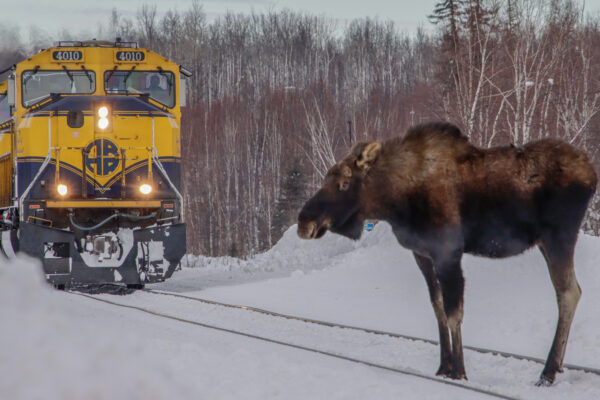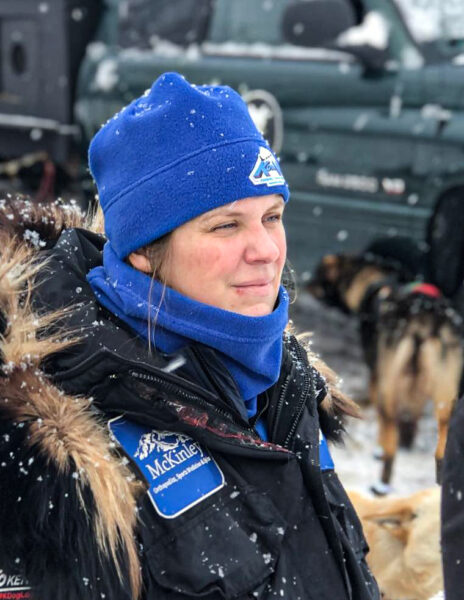
Iditarod rookie Bridgett Watkins and her sled dog team were cruising through a flat section of trail near Fairbanks a few weeks ago on a routine training run when she spotted a moose.
At first, she said, it sauntered toward her team. Then suddenly, it started charging.
“The next thing I knew he was running full speed straight at me,” recalled Watkins. “And I thought, ‘Oh, my God, this is really, this is really happening.”
She was holding her small .380 handgun. It was enough to slow it, she thought, but not enough to kill. She aimed, took a deep breath and unloaded a few shots straight at the moose’s chest. It didn’t even flinch.
Watkins ducked behind her sled just as the moose started trampling her team. Watkins was out of ammo. She said she was able to cut some of her dogs loose, but couldn’t free all of them and each time she moved, the moose seemed to get angrier.
She’d never seen a moose act like that in her decades of mushing.
“That moose had a look in his eye that he just wanted death to occur,” she said. “He just wanted to kill.

She was stuck there for nearly an hour until a snowmachiner arrived and killed the moose.
LISTEN: Musher Bridgett Watkins recalls harrowing moose attack
Biologist say aggressive moose like the one that attacked Watkins’ team are more common this winter in Interior Alaska because of, in part, a combination of deep snow and rain.
“The number of incidents between moose and people or moose and dog teams or moose and dogs is definitely higher this year than I’ve seen,” said Tony Hollis, an area biologist in Fairbanks for the Alaska Department of Fish and Game.
Mushers have reported encounters so close the moose scraped the hair off of their dogs. The moose have thwarted training runs. A few weeks ago, a musher near Cantwell reported being forced to kill two aggressive moose that charged his team. Mushers also say they’ve seen moose calves that looked near death from hunger.
Extreme rain and snow in December is the culprit, biologists say. Just before Christmas, the Interior was hammered by a bout of more than a foot of snow, followed by 2 inches of rain, followed by another foot of snow.
That made travel arduous for pencil-legged moose forcing them onto pre-packed trails that dog teams also like. They’re ornery from frequent run-ins with recreators, and predators like wolves have been pestering them, biologists say. They’re hungry and aggressive.
Hollis said moose encounters have even sent a few people to the hospital this year with serious injuries.
“I know of one of them, the person had multiple breaks in their leg,” he said.
Lately, reports of aggressive moose have spread south including into areas that Iditarod mushers will pass through.
Southcentral has been hammered by heavy snow mixed with rain over the last few weeks, and particularly heavy snow hit around Willow where the race starts.
“We got about 3 feet of snow in like a week, and now the moose don’t want to get off the dog trail. And they’re starting to get violent,” said Iditarod veteran Lev Shvarts, who lives and trains in Willow.
Biologists in Southcentral echo that sentiment, saying they’re starting to hear of more encounters in the past week. Shvarts said he’s taking precautions while training for the upcoming Iditarod, like asking friends for snowmachine escorts through the areas with a lot of moose.
As for Watkins, she said the memories of the attack are still with her.
“There’s been many panic attacks, like legit, ” she said, “The dogs, for the most part, seem completely unfazed.”
She said her injured dogs are recovering well after surgeries. Many of the dogs that were part of the team will be on the start line with her on Saturday.
As for herself, she’ll be there too, but carrying a bigger gun.
For more Iditarod coverage from Alaska Public Media visit alaskapublic.org/iditarod.
Lex Treinen is covering the state Legislature for Alaska Public Media. Reach him at ltreinen@gmail.com.





